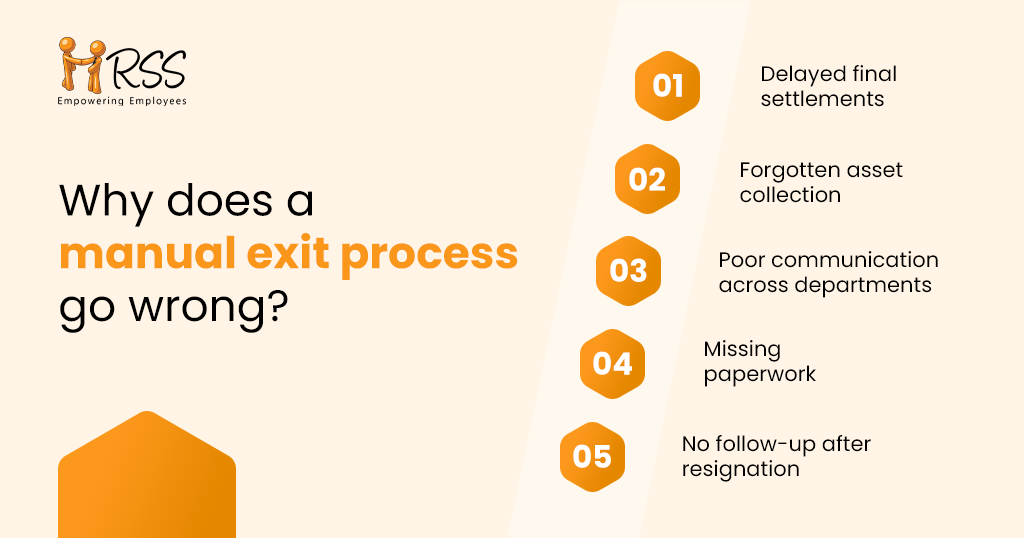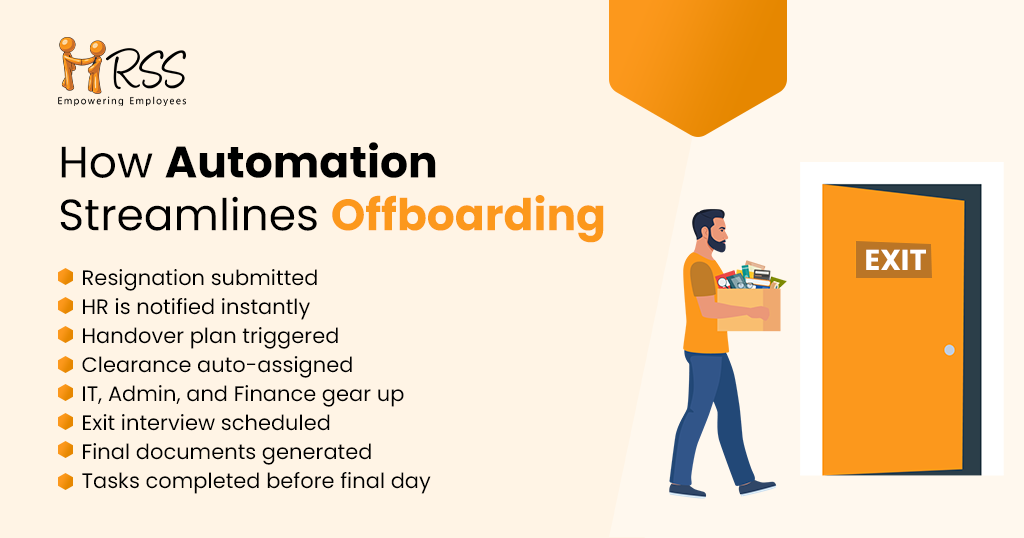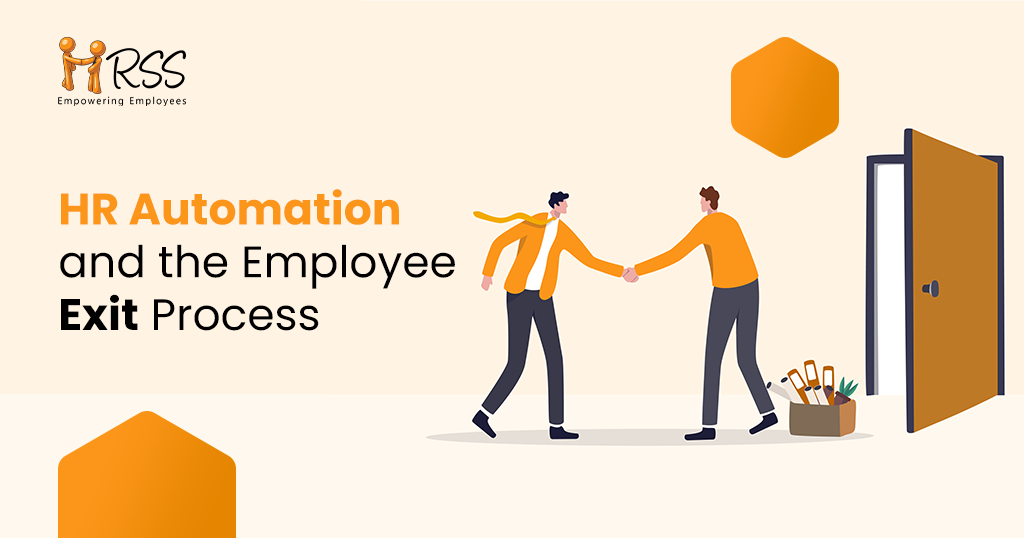You know that moment when an employee resigns, and your day suddenly goes off-track?
There’s a resignation email sitting in your inbox. Now begins the chase with informing IT, getting Admin to collect the ID card, sending reminders to Finance for full-and-final, and digging through folders for the exit letter template. Half of it is still done over email threads. The other half lives in Excel sheets that only one person knows how to read.
For many HR teams, employee offboarding is still one of the most disorganized parts of the employee lifecycle. It’s not intentional, it’s just that most exit processes haven’t evolved. They’re manual, fragmented, and stressful. However, with HR automation, you can finally bring structure to this chaos. You can stop chasing tasks and start delivering smoother, more respectful exits that reflect well on your company.
In this blog, we’ll walk through the common pain points in the offboarding journey, and how automation helps solve them for good.
Why the Employee Exit Process Should not be Ignored
A poor offboarding experience isn’t just frustrating for the HR team but also leaves a lasting bad impression on the employee too. And they talk. They leave Glassdoor reviews. They tell future job seekers. They might even decide never to return.
Here’s what usually goes wrong with a manual exit process in HR:
- Delayed final settlements
- Forgotten asset collections
- Poor communication across departments
- Missing paperwork or clearance
- No follow-up after resignation
According to a report, 66% of Indian companies admit to offboarding delays due to poor coordination, which is not just inefficient but risky too.

How does a Smooth Exit Experience Matter
People don’t forget how they’re treated on the way out. A smooth employee exit shows your company is respectful, mature, and organized. It reflects your culture.
And it pays off. According to LinkedIn, 43% of employees say they’d return to a previous employer if they had a good offboarding experience. That’s future talent, already trained, who trust your brand.
A great exit experience includes:
- Clear communication
- Timely payments
- Hassle-free clearances
- A proper goodbye
- A structured feedback loop
And the best way to deliver that? Automation.
What Is HR Automation?
HR automation means using software to manage repetitive, step-by-step tasks that don’t need human creativity, just structure. Think of it like setting a chain reaction: once a resignation is logged, every related action flows without needing manual supervision.
For offboarding, it can:
- Trigger department-wise clearance forms
- Assign tasks for asset return, payroll, and knowledge transfer
- Track document submission
- Schedule exit interviews
- Auto-generate letters and feedback forms
And it does all this without HR having to chase anyone. KPMG reports that 73% of HR leaders say automation improves compliance and team productivity.
Automating Offboarding Steps
Here’s how offboarding usually works, when it works well.
- Employee resigns
- HR receives and logs the notice
- Manager starts handover planning
- IT, Admin, and Finance receive tasks
- Exit interview is scheduled
- Final settlement and documents are prepared
- Everything’s done before the last working day
When automated, these employee offboarding steps move forward without manual nudges. Tasks are assigned. Progress is visible. Everyone stays in sync. Deloitte reports that automated offboarding reduces admin time by 60% and improves employee satisfaction during exit by 35%.

What Exit Process Automation Fixes
What if an employee submits the resignation, and instead of chaos, everything just…flows. That’s what exit process automation does.
It takes care of:
- Assigning tasks to IT, Admin, Finance—instantly
- Sending automated reminders until each task is done
- Scheduling the exit interview
- Generating experience letters, full-and-final statements, and clearance documents
- Tracking everything from a single dashboard
And it’s not just about speed. It’s about reducing errors, protecting your data, and showing your employees, they matter, even as they exit. A 2023 SHRM study found that businesses using automated exit workflows saw 40% fewer errors and saved over 20 hours per offboarding.
Why Automation Is Essential During Offboarding
Offboarding may be routine, but it’s far from simple. Each employee exit sets off a series of tasks that involve multiple departments, HR, IT, Finance, Admin, and line managers. Coordinating all of it manually not only slows things down, it increases the chance of missing critical steps.
That’s where automation becomes essential. It brings structure, consistency, and visibility to a process that often runs on scattered emails and follow-ups.
Here’s how automation helps during offboarding:
Reduces Human Error
When offboarding is handled manually, details can slip through the cracks. An access card might not be collected. A system account might stay active. Small misses like these can lead to bigger risks, especially when it comes to data security or compliance.
With automation, every HR step is predefined and assigned. Tasks only move forward when they’re completed. Nothing is left to memory.
According to Deloitte, companies that automate HR workflows see a 58% reduction in process-related errors.
Shortens Turnaround Time
In a traditional setup, it can take days to complete clearances and issue final documents. Automation changes that. It sets timelines, sends alerts, and escalates delays, keeping the process on track without constant follow-ups from HR.
This means faster handovers, quicker settlements, and less disruption for everyone involved.
Improves Transparency
Automation gives HR and managers a real-time view of each offboarding case. You can see what’s been completed, what’s pending, and who’s responsible, all in one place. That clarity removes ambiguity and allows smoother coordination across teams.
Creates a Better Experience for Employees
A disjointed exit process reflects poorly on the organization, no matter how positive the employee’s experience was while working there. Automation helps maintain professionalism until the last day.
Employees can complete tasks, upload documents, and fill out exit forms at their convenience. They stay informed throughout, without needing to ask, “What’s next?”
A LinkedIn report found that structured offboarding increases the chances of rehiring former employees by 43%.

Keeps the Process Audit-Ready
Every action, document, and update is logged automatically. This makes it easy to retrieve records during audits or internal reviews. It also helps HR maintain a clean, searchable history of resignations, clearances, and exit feedback.
In fast-growing organizations, handling exits manually becomes unsustainable. Automation not only brings control, it reduces risk, improves timelines, and supports your HR team in delivering a consistent, professional experience every time.
Don’t Let Your Exit Management Process Damage Your Brand
It’s easy to overlook the exit management process. But it’s a huge part of your employer branding.
Employees talk about their last day more than their first. If you make it frustrating, it hurts morale and reputation.
A thoughtful offboarding process shows that you:
- Respect people, even when they leave
- Care about compliance and structure
- Value feedback
- Protect sensitive data
According to Glassdoor, companies with strong offboarding are 2.5x more likely to attract rehires and referrals.
With HR automation, especially with tools like HRSS360, you can turn your offboarding process from a pain point into a people-first experience. Because exits aren’t just about letting someone go. They’re about leaving the door open, with dignity and grace.
Still Managing Exits on Spreadsheets? Switch to HRSS360
Manual offboarding is outdated. You’re chasing five departments for one clearance. Payroll delays become a regular thing. And half the time, no one even knows where the exit letter is.
If you’re tired of this, meet HRSS360. It’s built to simplify and automate everything about employee exits. HR teams using HRSS360 have seen a 42% drop in exit delays and report 60% faster offboarding cycles.
Don’t let one more employee leave with a bad experience.
Streamline your exit process today with HRSS360. Schedule a demo.





